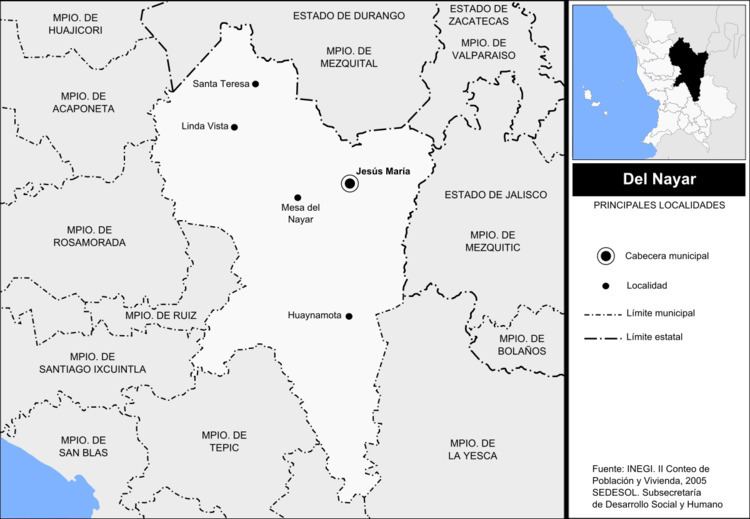Ethnicity Cora | Native speakers 20,000 (2010 census) | |
 | ||
Language family Uto-aztecanCoracholCora Regulated by Secretaría de Educación Pública ISO 639-3 Either:crn – El Nayar Coracok – Santa Teresa Cora | ||
Cora is an indigenous language of Mexico of the Uto-Aztecan language family. It is spoken by the ethnic group that is widely known as the Cora but who refer to themselves as Naáyarite. The Cora inhabit the northern sierra of the Mexican state Nayarit which is named after its indigenous inhabitants. Cora is a Mesoamerican language and shows many of the traits defining the Mesoamerican Linguistic Area. Under the "Law of Linguistic Rights" it is recognized as a "national language" along with 62 other indigenous languages and Spanish which have the same "validity" in Mexico [1].
Contents
Geographic distribution
Ethnologue distinguishes two main variants of Cora. One is called Cora del Nayar or Cora Meseño and is spoken mainly in and around the medium-altitude settlements of Mesa de Nayar and Conel Gonzales in the south of the el Nayar municipality of Nayarit, and has approximately 9,000 speakers (1993 census). There are significant differences between some of these varieties and some sources distinguish between Cora Mariteco (of Jesus Maria), Cora Presideño (of Presidio de los Reyes), Cora Corapeño (of San Juan Corapan) and Cora Franciscqueño (of San Francisco). But Ethnologue considers the mutual intelligibilitiy between these and Meseño to be high enough to classify them as a single language.
The other variant recognized by the Ethnologue is called Cora de Santa Teresa or Cora Tereseño and is spoken by approximately 7,000 people (1993 census), for the most part in the high sierra in the north of el Nayar. Cora de Santa Teresa has such a low degree of mutual intelligibility with other Cora speech communities that Ethnologue considers it a separate variety. Due to recent migrations a small community of Coras exists in the United States in western Colorado.
Dialects
Cora is spoken in a number of dialects, some of which have difficult mutual intelligibility. ISO distinguishes two languages, INALI nine.
El Nayar Cora / Jesús María Cora (Cora Mariteco)Dolores CoraRosarito CoraSan Blasito CoraSan Juan Corapan Cora (Cora Corapeño)Santa Teresa Cora (Cora Tereseño)La Mesa del Nayar Cora (Cora Meseño)Presidio de los Reyes Cora (Cora Presideño)San Francisco Cora (Cora Francisqueño)Classification
The closest relatives of the Cora language is the Huichol language together with which it forms the Coracholan subgroup of the Uto-Aztecan languages. The Taracahitan group of languages containing among others the languages Tarahumara, Yaqui and Mayo is also related to Cora.
Phonology
The phonology of Cora is typical of southern Uto-Aztecan languages, with five vowels and a relatively simple consonant inventory. However atypically of Uto-aztecan languages, Cora has developed a simple tonal system or pitch accent with an harmonic accent taking high falling tone.
Grammar
Cora is a verb-initial language; its grammar is agglutinative and polysynthetic, particularly inflecting verbs with many affixes and clitics. There are a number of adpositional clitics that can also be used as relational nouns.
Nominal morphology
Nouns are marked for possession and exhibit several different plural patterns.
Pluralization
Different classes of nouns mark the plural in different manners. The most common way is by means of suffixes - The suffixes used for pluralization are the following: -te, -mwa, -mwa'a, -tse, -tsi, -kʉ, -sʉ, -se, -si, -ri and -i. Other ways to form the plural is by reduplication of the final vowel of a noun stem or by shifting the accent from one syllable to the other. Another class of works form their plurals by suppletion.
Possession
Possessed nouns are marked with a prefix expressing the person and number of their possessor. The forms of the prefix expressing first person singular is ne-, na-, or ni-, for second person singular it is a-, mwa'a-, a'a-. The third person singular is marked by the prefix ru-. A first person plural possessor is marked by the prefix ta-, second person plural by ha'amwa- and third person plural by wa'a-. Furthermore, there are two suffixes. One, -ra'an is used to mark an obviative or fourth person possessor. The other is -me'en used to mark a plural possessum of a singular possessor.
Verbal morphology
Verbs are inflected for person and number of subject and direct object and object prefixes for 3rd person inanimate objects also show the basic shape of the object. Verbs are also inflected for location and direction.
Syntax
Typologically Cora is interesting because it is a VSO language but also has postpositions, a trait that is rare cross-linguistically but does occur in a few Uto-Aztecan languages (Papago, Tepehuán, and some dialects of Nahuatl).
Media
Cora-language programming is carried by the CDI's radio station XEJMN-AM, broadcasting from Jesús María, Nayarit.
